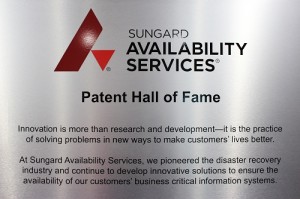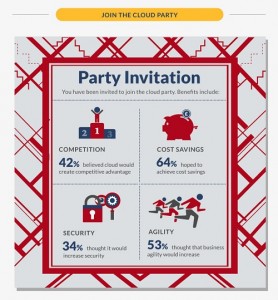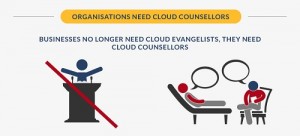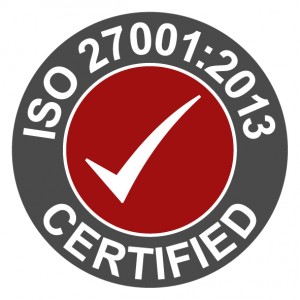As Senior Vice President of Consulting, Mike Threlfall talks about the role consultants can play in reducing risks and taking on the forces of change.
Q: What IT trends make consulting services more important than ever to customers now?
Mike: With recent security incidents, customers are now more focused on building an appropriate response to cyber risks, and we’re seeing that across the world. Another trend driving the need for consulting is digital transformation, where organisations are trying to respond to the increasing digitization of the global business landscape.
In both cases, they’re looking for insight into how other companies approached similar situations—what worked badly, what worked well—to help them decide the best course of action. Quite often, they don’t have that type of experience inhouse, so that’s why the injection of outside consulting services is important.
We provide advisory services around business resilience and continuity, risk management and infrastructure transformation. To help customers formulate an appropriate response if a security incident occurs, we assess their overall infrastructure and security processes from top to bottom, then run crisis simulations, coaching individual executives and teams about how to respond effectively, while maintaining a programme of ongoing vigilance.
When it comes to digital transformation, we assist customers in figuring out how to adapt their infrastructure technology and IT services to effectively support and enable the required change. We can also go on to develop, manage and implement an IT transformation programme to enable digital business services.
Q: Where are most companies in the digital transformation process?
Mike: In some industries, such as banking, retail and telecom, the more traditional Internet and mobile-based digital channels and their breadth through the value chain is relatively mature. In other sectors, such as manufacturing, transportation and logistics and construction, digital uptake is much lower.
For public sector, digital government services are leading the way. But, without doubt, the long period of austerity has held back developments. The paradox here is that digital transformation is a survival imperative for both local government services and the NHS in their current form. An aging and growing population and continued austerity require solutions to drive lower costs, while retaining citizen intimacy. However, it remains to be seen if investments and funding models will appear in the near term to enable the necessary large-scale changes required.
The next waves of the Internet of Things (IoT), machine learning and artificial intelligence (AI) with business analytic integration across the piece, are well underway. The enhanced relevance of these technological advances across industrial, construction, manufacturing, transportation and logistics and healthcare sectors, as well as their relevance to more mainstream digital protagonists, is undoubtedly fueling a massive drive for digital transformation.
The plethora of newly established positions, such as digital directors, heads of digital and other associated roles are evidence that, whilst this wave is still immature, traction is rapidly growing; with ecosystems of partners evolving driving proof of concept developments running alongside more traditional and business as usual technical environments.
So, digital maturity levels vary significantly across sectors and individual companies, but the rate of change and digital transformation across all sectors is ramping up massively. The difference is really just a matter of their starting point and target business outcomes. However, the magnitude and speed of digital transformation is also heavily intertwined with factors, such as investment appetite and economic uncertainty.
Q: How are other market forces creating a greater need for consulting services?
Mike: The wider acceptance of hyperscale cloud and the next waves of digital transformation incorporating IoT, machine learning, AI and associated business analytics are all increasing the demand for consulting engagements. Customers want to exploit the scope, price and competitiveness of hyperscale platforms, but need help figuring out which workloads and services to deploy in that environment.
They also want to understand and exploit the business benefits from the latest developments in digital technologies, but, again, they need assistance in defining business outcomes and developing the infrastructure and services to enable their digital services, including where hyperscale cloud plays within this context.
We have a modular set of transformation services that start with defining a cloud strategy, then surveying and documenting the application landscape to discover the business-critical characteristics of those applications, as well as their infrastructure dependencies, level of maturity, architectural, technical and commercial readiness.
Next, we map those applications and business services to the appropriate platforms. They can be hyperscale in the cloud or run in different types of hosted or physical environments, depending on the needs of a particular business service or application. We really don’t find any customers who have a requirement that fits entirely into any one of those platforms because we’re dealing with hybrid infrastructures today that have to run in harmony. We can then implement the infrastructure changes for them, assessing and remediating any availability and security risks as we do so.
Q: How do you help customers manage the challenges of IoT?
Mike: The number and hyper-connectivity of devices, including sensors and edge devices sitting alongside more traditional technology forms, is set to explode. This is creating an unprecedented amount of data that customers need to capture, transmit, store, secure, backup and recover. They also need to analyse it to turn the data into useful information, then deliver it to those in the organisations who need it to do things differently, better, faster and cheaper.
We’re working with one aviation customer who is aiming to automate resource scheduling, such as those required for refueling, based on real-time information about when planes land. So, they are stitching a lot of different pieces of data together from many different sources, including sensors, to make smarter decisions and increase efficiency.
That style of real-time access is being considered for all areas of commerce now, which is driving the need for specific consulting around infrastructure architectures to support IoT and business analysis platforms, data storage, backup, recovery and data security.
As smart devices collect large volumes of different data types and connect back into corporate resources and networks, they create the need for architectures and integration to support “real time” data transmission and access performance requirements, along with appropriate storage, backup and recovery solutions for large data files, such as images and videos, as well as small log file type data.
Invariably the ecosystem to support such services expands, requiring the appropriate service integration of providers to assure service quality. Further, with lots of extra entry points where threats can get in, companies need to determine how IoT affects their risk and security stance and what they can do to minimise additional exposures. Sungard AS consultants can help our clients assess their current environment and readiness and create appropriate strategies. They can assist customers in realising those strategies to cover all these areas in terms of people, process and technology.
Q: What makes Sungard AS different in the consulting area?
Mike: First of all, when it comes to technology, we are impartial. If you went to another vendor, you could be pushed to a specific technology, platform or partner solution—whether overtly or not. Customers also get to work with seasoned experts, with a deep competency in the areas of business resilience and continuity, risk, infrastructure transformation and security.
We also have proven methodologies in areas of business resilience, continuity and risk, and responsibility for success pervades the whole organisation. With that in mind, we take a holistic approach, often starting with the most senior customer executives. With our heritage in protective services, we speak the language of both business and IT and can act as an effective integrator of the two.
Within the context of infrastructure transformation, we have a proven modular methodology, flexible enough to accommodate an agile approach and minimum viable solution concepts to deliver benefits more rapidly. As you can also imagine, our protective services heritage and proven and risk-managed migration methodology gives clients confidence as we migrate them from their current to their target mode of operation.
Within our cloud and infrastructure practice, we also address the growing skills gap in delivering and supporting digital developments. We offer residency services to augment our clients’ internal staffs, so that they can move forward with digital – enabling infrastructure transformation. We also offer post-implementation residency for knowledge transfer about their new infrastructure and IT services.
And finally, we’ve got a very solid track record, backed by an impressive set of customer references.
Q: Is there anything on the horizon that’s going to make it even more imperative to engage a consultant?
Mike: Concerns around the security of internet-facing services, and the increasing interconnection of services, will still be a challenge. As more IT services are connected between companies, it will change the way your organisation needs to think about your IT, because it’s no longer your IT, it’s in a much wider world.
So, the old-fashioned notion of building a fortress IT shop went away a while ago, but I think there are still plenty of organisations that haven’t really figured out how that impacts them.
Compliance regulations will also influence how organisations handle, protect and profit from data, and I don’t think many appreciate just how intrusive those regulations are likely to be. For example, although the General Data Protection Regulation (GDPR) is a European law, it applies worldwide wherever your company is based. Regulators are operating behind the curve, given the pace of technology innovation that we are currently experiencing. I expect to see a raft of new regulatory requirements appear, both broadly and within sectors over the medium term, some of which are likely to have quite profound implications.
When it comes to the digital technology revolution, there are no signs of slowing pace. Current waves will mature and newer ones, such as those in the areas of robotics and digital currency, will start to mature and emerge.
So, in the future, I think there will continue to be technologically driven change and new risks and regulations for customers to deal with, but there will also continue to be tremendous opportunities.
To help strengthen your security stance, check out our free Risk and Resilience in 2017 webinar.

 Download the white paper
Download the white paper
 A new
A new 




 By Michael Smith CEH, SSCP, CISSP
By Michael Smith CEH, SSCP, CISSP  Mike Smith has spent over 30 years in IT, 24 of which have been spent with Sungard Availability Services. During this time, he has provided hands-on communications support; post and pre-sales support for both systems and communications and has been manager of both pre-sales support, technical support groups and worked extensively as a Senior Product Development Manager.
Mike Smith has spent over 30 years in IT, 24 of which have been spent with Sungard Availability Services. During this time, he has provided hands-on communications support; post and pre-sales support for both systems and communications and has been manager of both pre-sales support, technical support groups and worked extensively as a Senior Product Development Manager. Watch the webinar
Watch the webinar Watch the webinar
Watch the webinar Hibernia College
Hibernia College Last issue, we talked about what the new
Last issue, we talked about what the new 
 Forrester identifies the ten most significant DRaaS providers based on 26 different criteria in three categories. The detailed report shows how each provider measures up against each of these measures and also where they stand in relation to one another. Thorough analysis showed that Sungard AS, along with three other providers from a shortlist of ten, “lead the pack”. We received the highest score for ‘Strategy’ and ‘Current offering’:
Forrester identifies the ten most significant DRaaS providers based on 26 different criteria in three categories. The detailed report shows how each provider measures up against each of these measures and also where they stand in relation to one another. Thorough analysis showed that Sungard AS, along with three other providers from a shortlist of ten, “lead the pack”. We received the highest score for ‘Strategy’ and ‘Current offering’:
 “These honours underscore our dedication to providing customers with continuous access and protection for mission-critical data,” said Carmen Sorice, senior vice president, global channel sales & programs, Sungard AS. “Users expect access to information on any device, anytime and anywhere. Our goal in working with Dell EMC is to give customers the access to applications and data they need, while ensuring their data is protected at all times, wherever it resides.”
“These honours underscore our dedication to providing customers with continuous access and protection for mission-critical data,” said Carmen Sorice, senior vice president, global channel sales & programs, Sungard AS. “Users expect access to information on any device, anytime and anywhere. Our goal in working with Dell EMC is to give customers the access to applications and data they need, while ensuring their data is protected at all times, wherever it resides.” “These awards recognise what we acknowledge every day at Sungard AS,” said Carmen Sorice, senior vice president, global channels, Sungard AS. “We employ some of the most dedicated, influential, and accomplished players in the channel, who are continually forging stronger partnerships and generating greater value for our partners and customers. It would be an honour to have a single team member included among the Women of the Channel, but to have eight confirms our depth of talent and their degree of accomplishment.”
“These awards recognise what we acknowledge every day at Sungard AS,” said Carmen Sorice, senior vice president, global channels, Sungard AS. “We employ some of the most dedicated, influential, and accomplished players in the channel, who are continually forging stronger partnerships and generating greater value for our partners and customers. It would be an honour to have a single team member included among the Women of the Channel, but to have eight confirms our depth of talent and their degree of accomplishment.” 











































 We were also triumphant at the
We were also triumphant at the 











